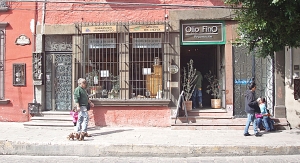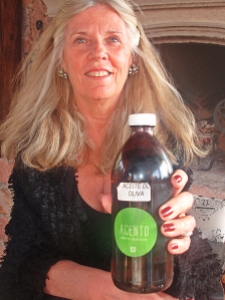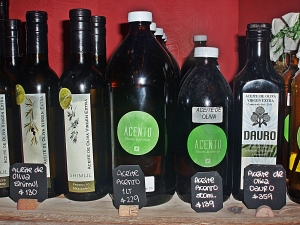I decided to have an olive oil tasting the other day. I’m not sure why. Other than olive oil has always mystified me. That and the fact that everywhere I seem to go there are olive oil shops and bars with the word degustation outside. Maybe even more of them these days than places offering wine tastings. Oh, and I also wanted to discover one more thing. Are those $20 bottles of oil really that much better than the $7 ones?
As you may already know, olive oil is not the nicest business in the world. You might say it’s darn right nasty. For instance, did you know there’s a good chance that the Made in Italy olive oil you’ve been enjoying for years isn’t really made in Italy. Much of that Italian oil actually comes from Spain, Morocco or Tunisia. What happens is, after the olives are picked, they’re driven to a mill for crushing and then the oil is pumped into big tanker trucks and driven to Italy, the world’s largest importer of olive oil. In Italy, the oil is then packaged into cans and bottles and a label is placed on them with those Made In Italy words. And that’s perfectly legal. Hmmmm!
And the olive oil story gets worse. Much worse. A whole lot more nasty. A considerable amount of the oil that arrives in Italy from countries like Spain isn’t even olive oil; it’s just labelled that way to get through customs. In fact much of it comes from soybeans. It is then mixed with real olive oil as well as beta-carotene to disguise the flavor and cholorophyll to improve the color. A piece in last Sunday’s New York Times estimates that 69% of the olive oil that’s shipped all over the world from Italy is doctored.
Despite all that criminal activity, I still wanted to taste the differences in olive oils. Maybe it was like doing crime without the chance of doing time. I recruited foodie friends Ben and Cheryl and, of course, Don Day’s Wife who gave me one of her “do we have to do this looks” until she learned we were using sparkling wine to cleanse our palates.
We lined up five different olive oil bottles. Two premium oils came from Olio FinO, that nice little…no make that nice big…shop on Zacateros here in San Miguel de Allende that has a bewildering number of oils and vinegars and has that word degustation outside. We included two of what I would call your basic supermarket olive oils. Plus there was one premium Mexican oil from Carnevino.
When I stood them up like soldiers for a photo, I couldn’t help but wonder. When a few bottles of olive oil get together, do the extra virgins look at the others and think “those sluts”.
Actually these olive oils were all classed as extra virgin but what exactly is extra virgin olive oil? It is not, as Don Day once suspected, the oil that comes from the ugliest olives. In fact, it may be better for me to start my explanation with what extra virgin olive oil isn’t.
Extra virgin olive oil is not the product of passionate growers with low yields of the finest varieties of olives, gathered by hand at the peak of their ripeness, and then delicately pressed using centuries old machinery.
No, there are only three strange (to Don Day anyway) rules for an olive oil to be classed as extra virgin. The oil must be pressed mechanically (no help from chemicals). It must have an acidity content of less than .8% (apparently the lower the acidity, the less chance of the oil having a rancid taste). And it must have fruitiness and no defects in the taste (there are recognized tasting panels that do this for a living…sounds like a nice job if you can get it).
What all of this gets down to is you have don’t have to be classified as extra virgin to taste good and being classified as extra virgin doesn’t necessarily mean you’re going to taste good. What influences taste is the type of olive, the growing conditions such as soil and weather, and, most importantly, when the olives are harvested.
According to Nancy Ash, author of Strictly Olive Oil, “Oil made from predominantly unripe (green) olives contains flavors described as grassy, artichoke, or tomato leaf, whereas riper olives tend to yield softer flavors often described as buttery, floral, or tropical.”
Tomato leaf? It sounded like an olive oil tasting exercise has just as much sophistication (or, in some people’s opinions, just as much BS) as wine judging methods. When I went to the internet in an attempt to learn the proper way to evaluate olive oil, Don Day found a tangled web of scoring methods that make olive oil judging seem like rocket science compared to wine judging.
Cheryl printed out copies of the University of California Cooperative Extension 15 Point Olive Oil Profile Sheets. The score sheets had flavor descriptions such as fresh cut grass, eucalyptus, wood, green apple, ripe banana (as well as green banana), mint, green tea and hay/straw. We looked at them once, looked at them again, and decided to throw the sheets in the fire.
The olive oil tasting was sounding a lot like a wine tasting but with one exception. The olive oil tasting guides did have one description that Don Day welcomed and that was the taste of olives. One never sees the taste of grapes on a wine tasting guide.
We decided to come up with our own measurement system for tasting the olive oils, we would rate them on a less sophisticated but, in our opinion, much more practical way. We would rate them based on how good they tasted. Here’s how they rated, from last to first.
Olivos Mendoza
Olivos Mendoza, one of the supermarket selections, had been picked up by Cheryl at our local Mega based mostly on it being made in Mexico.
To put it mildly, we did not react well to the strong taste. We all agreed that it had an almost offensive odor and all we could say good about it was it was greasy. Don Day couldn’t imagine how a tasting panel would even give it an “extra virgin” rating.
Cheryl said, “I’m not even sure I’d cook with it.”
Perhaps this was one of those illicit, doctored oils but there was no way we could know. Olivos Mendoza received by far the lowest score with a 50.
Picual Oro Bailen
Next in the standings was a Spanish oil from the Olio FinO shop and, based on its price of 250 pesos for just 375 ml, the most expensive Don Day could find in San Miguel, it was one we had great expectations for. This one did taste like olives and it did have a nice, nutty flavor.
We all agreed, however, that there was a bitter aftertaste and that’s not something you want from the most expensive olive oil you’ve ever bought.
The scores for Picual averaged 84.
Serpis
This was the other oil from the supermarket, Mega. It’s imported from Spain and distributed by Mercantil Cuautitlan in Mexico.
Nobody had much to say about Serpis with the comment that best summed it up being Ben’s, “It’s very inoffensive.”
Serpia scored an average of 85.
Cerasuola
This was the second oil that came from Olio FinO but at 140 pesos for the 750 ml size, it was a third the price of the Picual. Cerasuola is from Sicily and was the one that we thought best represented the taste you’d expect to get from less than perfectly ripe olives.
When you swallowed, it left a stinging sensation in your throat; it was almost hard to breathe; it was like you’d just gulped a habanero pepper; it made you want to cough.
We didn’t quite know how to react to this. Was it a bad attribute of olive oil? Or perhaps good. After the tasting, Don Day did a little more research. That stinging in the throat is a sign of an olive oil of robust intensity and, yes, that’s a good thing among olive oil experts.
I don’t think the pungency and what it did to our throats affected our scores much as the Cerasuola averaged a very respectable 92.
Acento
Finally, there was Acento, the pricier, made in Mexico oil that I’d picked up at Carnevino, the, as the name suggests, meat and wine shop on Ancha de San Antonio. This oil punched us square in the palate.
“This tastes so fresh,” said Ben.
“It’s like a perfume; there are flowers on the nose,” said Cheryl.
“I’m getting almonds, honey, maybe coconut,” said Don Day’s Wife.
“This would be great on a salad,” said Don Day (and later that afternoon it was).
We had discovered an olive oil we really liked. We gave it a 93. But we wondered. Was this what serious olive oil afficionados would like? It had hardly any flavor of olives and on every tasting guideline I’d read that was one of the key factors.
Maybe, though, it was like that fruity wine that the critics put down because it has no depth or character but just tastes damn good to the average joe.
Don Day decided to try and discover why Acento was so different and wrote to the company to find out more about the varieties of grapes, where they were grown, when they were harvested, and the acidity level but alas, I received no response. I’m beginning to think that the Contact Us portion of websites should really say Contact Us. But Don’t Expect A Reply.
My guess is that the oil came from exceptionally ripe olives for it’s from fruit that’s picked later that you get tastes like tropical, banana and buttery which are a lot like the flowers, almonds, honey and coconut that we discovered when tasting Acento.
Whatever’s in Acento, it tasted good to us.
So back to what Don Day was trying to discover with an olive oil tasting. Were there major differences in the tastes of olive oils? Absolutely. And even though Acenta, our number one oil and Cerasuola, our number two were only one number apart on their scoring, they were miles apart in their tastes.
And that other question. Are those expensive olive oils worth the extra money over those mass market ones found on your supermarket shelves? Yes, Don Day thinks so.
I wouldn’t use Acento for cooking. At 229 pesos or almost $20 for 3/4 of a litre that would be a little too extravagant. But Don Day is definitely planning to have a bottle in the cupboard for those special occasions. Like when I’m going to combine it with balsamic vinegar and parmesan and soak it up in a baguette. Or when it’s going to be mixed with lime juice and a few select spices and pour it over fresh greens.
I just hope that it really is olive oil and those olives really were grown in Mexico.
Acento is available at Carnevino, Ancha de San Antonio #21 in San Miguel de Allende, Mexico.







Have you ever tried the olive oil at Luna y Queso.?
Not yet. But I’m going to. Though I’ve got a lot of other oil to get through first.
What delightful writing, Don Day! Mil gracias!
Thanks very much for visiting Olio Fino and helping to educate readers about the extra virgen olive oil. The Cerasuola and Picual Oro Bailen you mention are both categorized as robust oils which means they have a very high polyphenol content (a class of antioxidant). This is what produces the peppery finish in the throat. Since robust oils are often produced from early harvest olives, they often tend to have some bitterness, as the olives are not fully ripened. In fact, the three qualities that are scored by professional tasters are fruitiness, bitterness and pungency. Robust oils typically score higher on the latter two characteristics.
It is true that many customers are not accustomed to the strong flavors of robust olive oils, instead they are used to refined or ¨light¨ oils that are bland, even tasteless and offer little or no nutritional benefits. For customers that prefer reduced bitterness and pungency, yet still want a fresh herbaceous authentic extra virgen olive oil, we recommend a milder variety. Among the 10+ extra virgen olive oil varieties in Olio Fino, there are numerous varieties of mild or medium intensity oils. So there really is something for everyone´s palate. This is the benefit of offering the tastings… customers learn about the products and are sure to find a fresh, authentic extra virgen olive oil that is to their liking. For example, Oro Bailen is one of the most prized olive oils in the world, but just because it scores high in professional tastings does not make it everyones favorite 🙂
Hopefully you can visit the store again so we can offer some tastings of milder oils with more fruitiness… I am sure you will find your new favorite olive oil in Olio Fino!
I´ve tried a lot of olive oils and I definitely give a 10 to olio Fino, it´s just the most exquisite place in San Miguel de Allende.